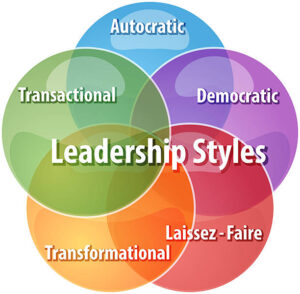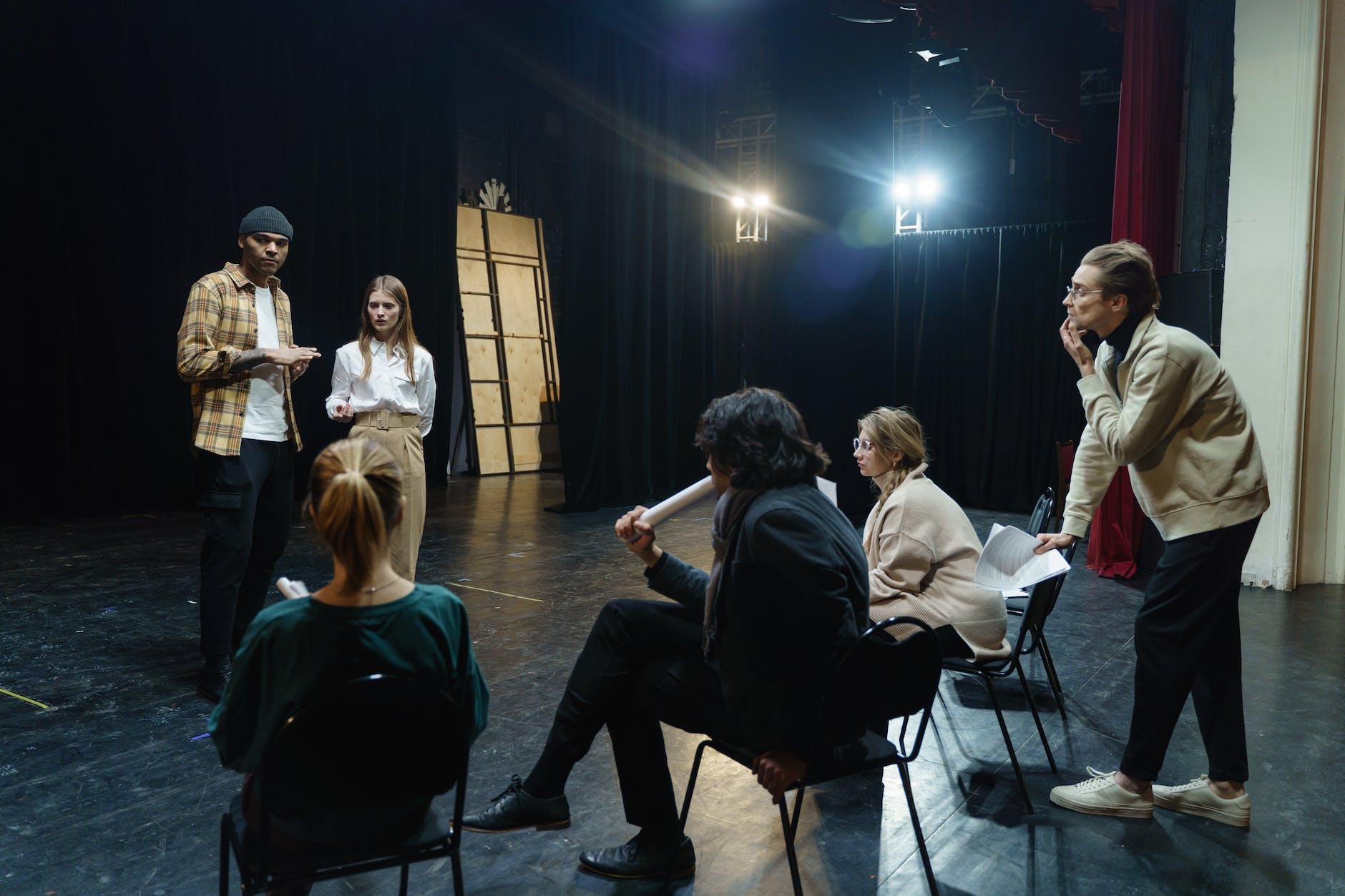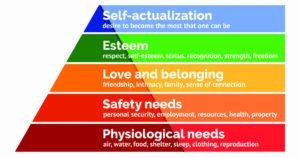LEADERSHIP
You, your Troupes, Groups,
and Impro Partnerships
(Part 2: YOUR STYLE)

In Part ONE of our look at leadership for you, your troupes, and your groups we focussed on your vision and mission. Knowing what you aim for makes the choices and journey easier, more productive, and rewarding- not to mention, you are more likely to achieve some level of your expectation of success.
In part 2, we’ll look at:
YOUR LEADERSHIP STYLE 
How you lead attracts some people and pushes others away. Your style makes some tasks easier and others impossible. Knowing your strengths and weaknesses will save you in the long run.
By default, your style of leadership is primarily affected by who you are. Remembering that there are other options though, can help you bend when flexibility is needed so that limited ‘style’ doesn’t become a thing that holds you back.
In this article we aren’t talking about your knowledge or the content of what you offer. We are considering how you get what you know across to others and how you motivate and move the group.
In part three we will talk more about the specific skills.
LEADERSHIP PHILOSOPHY –
Researching this topic, I was fascinated by a few things. Interestingly, (for me at least,) our current ideas of leadership only exist from ideas developed since the 1940s and the word LEADERSHIP can’t even be traced to the English language before 1821 in the Oxford Dictionary.
(Before then it must have been chaos!!!)
Before 1939 the theory of Trait  Leadership said you were born to lead or you weren’t. Along came Kurt Lewin who looked at how children responded to leadership. He identified 3 styles:
Leadership said you were born to lead or you weren’t. Along came Kurt Lewin who looked at how children responded to leadership. He identified 3 styles:
- AUTHORITARIAN
- DEMOCRATIC
- LAISSEZ-FAIRE
Since then, the number of Leadership styles varies depending on which expert you talk to. Search the web and you’ll see claims of 7 to 17 styles. Let’s start with Lewin’s three that began this exploration.
Authoritarian Style (or autocratic)
As the name implies, leaders with an Authoritarian style control all decisions. Most of us Improvisers question this approach but there is a place for it and some of you use it without thinking about it… you control freaks! 🙂
Authoritarian leadership qualities:
- They are direct
- Comfortable giving the orders
- Leave little room for creativity from others
Steve Jobs – APPLE: 
If you have a strong vision and clear communication skills, you probably have more of the autocratic style Steve Jobs had. He was notoriously difficult where collaboration was called for. He took the reigns and steered the company.
Maybe it’s not the best leadership style for all improvisation situations BUT there are moments the Authoritarian can lead improvisers to success.
- In situations where quick decisions are needed
- Emergency situations
- When the leader is most knowledgable
- When work needs to be done and it just isn’t happening
Imagine a corporate improvisation group where the performers are unfocused and risk the group’s chance of doing their best work because they lack the professionalism needed.
The Autocrat’s strong guiding hand might save the day here. Sitting back and allowing the group to continue down their chaotic path would likely lead to disaster.
Sure, “there are no wrong answers in Improvisation. Yes to everything”… but when it comes to certain work, accomplishing what MUST be done means the financial life or death of some groups.
Even considering the safety of a group. There are some areas where the authoritarian can protect the group from immature or questionable choices that would leave the more vulnerable people in your group at risk.
If this is your style, you can be successful but be cautious to show Respect for those you guide. Acknowledge input and recognize accomplishment (giving value to the individuals in your care)
Be Consistent, and reliable and earn trust. This leadership style isn’t actually about being a control freak or making you, personally look good. Without the group, you can’t create the vision you want.
The authoritarian leader serves the vision. BE CLEAR about what you want. This leadership calls heavily upon the need for a great communicator.
On the other end of the scale is the…
Democratic Leader.
The Democratic leader often participates with the group as an equal in most regards.
They encourage input and make an environment where opinions can come forward.
Democratic leaders aim the group and walks forward with them, ready for the change that is made together. This leader nudges the group in directions that were agreed upon in the overall vision that defines the group and facilitates the choices that are needed helping to amplify the group mind.
- This is a great style when lots of creativity is needed.
- It benefits groups where the feeling of participants is highly valued.
- It’s great when there is a high level of competence in the group
It’s more time intensive and less beneficial when there are lots of deadlines and choices to make.
It’s a disaster if the group is not skilled. I’ve seen groups controlled by misguided choices that drive themselves over the cliff because the loudest voices in the “democracy” were the least capable.
As many in the arts have said,
- Art is not democracy.
-R.R. Martin
As the leader, your facilitation skills are called upon highly.
- Encouraging quiet voices and getting all opinions out fairly and efficiently are important.
- You better have some great empathic qualities to see how people are feeling. Democracies can falter with weak guidance or the creation of an out-of-balance situation with some people having more power than others.
- The ability to move forward means that you might have to decide on one direction over the other. Knowing how to do that while not shutting out those who want an alternate choice takes great skill.
AUTHORITARIAN and DEMOCRATIC leadership skills happen in some form with all groups.
The third big style is rarely talked about but often happens by default.
LAISSEZ- FAIRE
The LAISSEZ-FAIRE style (French for “ALLOW TO DO” – often called the “do nothing” style – ) happens with people who use a hands-off approach.
This leader doesn’t so much decide things as they acknowledge decisions have been made.
The leadership will not influence the direction of the group directly.
Successful Laissez-Faire leaders are generally popular and competent. The group looks up them. People want to do what the leader is doing.
By their behaviour, they are perfect role models and a passive presence commanding great respect.
Thinking about this in my own experience, I would have to say that this style strongly represented Keith Johnstone at the Loose Moose Theatre in the early days of Improvisation development at the company.
experience, I would have to say that this style strongly represented Keith Johnstone at the Loose Moose Theatre in the early days of Improvisation development at the company.
He rarely told people what to do. “Let’s try things and see if they work!” But his suggestions lead inspirationally.
This style works well with great teams that are already established or have universally accepted the leader as the ideal authority to emulate.
The problems are easy to see. It doesn’t work in an unmotivated group or one where the skills are low. The chance of frustration is high as the projects float around without anything moving forward. (often stronger voices will take over)
If you use this style – provide what is needed for skilled people in your group to succeed. Be ready to step in. Be clear about upcoming deadlines and remind them of their own choices as they move forward so they can stay on track.
Other styles of leadership emerge from these three.
TRANSFORMATIONAL leadership gets deep…
Transformational leadership takes from Maslow’s HIERARCHY OF NEEDS…
From SimplyPsychology.org,
From the bottom of the
hierarchy upwards, the needs are: physiological (food and clothing), safety (job security), love and belonging needs (friendship), esteem, and self-actualization.
Needs lower down in the hierarchy must be satisfied before individuals can attend to needs higher up.
Transformational leaders take care of the entire person.
They aim to take care of individuals
- Basic needs (creating physical comfort)
- Safety (creating psychological comfort)
- Belonging-ness and feelings (creating safety in spirit)
Body – Mind – Spirit.
The motivation is to bring the individuals greater overall ease and confidence – a closer feeling of being complete.
That’s a big task BUT… Think about improvisation generally. The picture of acceptance, inclusion, empathy and understanding go a long way down the path of transformational leadership.
In caring for the person, the Transformational Leader is building a highly motivated and inspired participant who can help move the group forward and feels committed to the grop with a sense of ownership to the project. This also develops future leaders in the group.
 Barrack Obama fell into the category of Transformational leaders. He stayed connected and engaged those around him on deep levels.
Barrack Obama fell into the category of Transformational leaders. He stayed connected and engaged those around him on deep levels.
The important visionary qualities of transformational leaders tend to pull the group forward empowering those in their circle to take control. If you can’t give up control, you likely won’t connect well to this style.
This style connects well with successful improvisation groups because of it’s connection to risk-taking, positivity and openness.
Here’s a little video hilighting transformational leadership style
TRANSACTIONAL leadership:
In the style of the capitalist ideal, we find Transactional leadership. It’s a common style seen in typical businesses.
Transactional leadership pays for the outcomes. If you hire someone for your group, you already have some elements of transactional leadership.
This leadership begins in negotiation. “IF YOU – come to rehearsal, come to the show, etc, I WILL GIVE YOU, money, position in the group, training, etc.”
I think about the studies that argue against this style when it comes to inspiring people in the long term. A common cognitive bias -OVERJUSTIFICATION EFFECT – occurs that reduces inspiration and motivation.
Over at theDECESIONSlab.com they write:
The overjustification
effect describes our tendency to become less intrinsically motivated to partake in an activity that we used to enjoy when offered an external incentive such as money or a reward…. It can cause us to abandon activities that we actually find intrinsically valuable once we are presented with a prize or money for doing the activity. Instead of the rewards adding value to the activity, they take away from it.
In a classic experiment by David Greene and Mark Lepper, the findings showed that children paid to create paintings lost their long-term interest to create. The reward became more important than the activity. Remove the reward and the activity loses its attractiveness.
That’s Sad and Depressing! Be careful not to crush inspiration by paying for it to happen. Inspire. Don’t monetize.
The mix:
Rarely are transitional and transformational styles of leadership entirely separate.
There may be a certain element of transaction ocuring while at the same time transformational inspiration motivates the group to create and perform from a deeper place than pay or position.
There are a few more styles of Leadership but you are looking tired so I will focus on just one more.
SITUATIONAL Leadership.
Probably most suited to Improvisation work, SITUATIONAL Leadership responds to the SITUATION of course. It also responds to the participants.
If you have an easy task and an extremely competent group, back off, give them space, and participate with them. If you have a beginning group facing the same task, you would probably jump in with something closer to the autocratic style. Guide them more directly.
Situational Leadership calls specifically for adaptive people to consider who they’re working with and what they’re working on. It makes great focus on what skills the group has at hand.
The Director Leads in Maestro
Those of you who direct the Maestro Impro format by Keith Johnstone might recognize how situational leadership relates to the director’s evolving role over the course of the show.
With a varied group of performers at the beginning of the night, there might be a some performers who have never been on stage before. In those scenes, the director supports with a stronger style.
By the end of the show, the skill level of performers becomes higher as others are eliminated. At that point, there is less necessity for help from the directors who expect you to lead your scenes and play at your level without any directorial interference.
The director changes leadership from Autocratic to Laissez Faire and hopefully the show benefits from this flexible leadership.
USING ALL OF THIS
Lead yourself.
Change how you treat your own behaviour based on how leaders lead bigger groups. Be transformational when you should be caring for your spirit. Be the Autocrat when you are getting lazy. Be Democratic when you stand at the crossroads of choices that challenge you. (Talk to others and get opinions and choose from what the majority of reasonable people suggest).
Lead your group.
Know your vision and set that target ahead of you. Know your group and give what they need and what you need. If the group are strangers off the street, don’t take the Laissez Faire approach. The group won’t survive. If the group are professionals and peers with similar or greater knowledge, don’t be the autocrat.
Know your project:
If you have a partnership and are working on a one-time performance, a little Laissez Fair style might suit you both. Set your timeline and adapt to your approaching deadline as the needs arise.
Leading the Vision:
Start as the authoritarian. Set out clearly what you want. Mix in some transformational leadership as you set the groundwork for the upcoming project. If everyone is feeling great and showing initiative and creativity, step in with them on a democratic level and create.
CONCLUSION – (sort of)
Be honest. Know what you will tolerate, what you can offer and what you want.
tolerate, what you can offer and what you want.
If you see that your group needs something else, incorporate another style. Get others who exhibit that other style to share leadership, or pass on your leadership to someone more suited to the group’s needs. IT’S NOT ABOUT YOU.
Like an improvisation class which needs a specific exercise at a specific time to benefit the students, certain styles of leadership can benefit or damage your group and should be considered as you, your group and your projects mature and evolve.
Don’t take the suggestion for flexibility to mean that you will change every moment there are bumps in the road. If you have a reasonable element of awareness you’ll know when it’s time to shift styles.
As I said in the beginning, there are numerous styles. If you are interested in a greater picture of 17 styles? Look here. …
In the end, IMPROVISE! Adapt. Lead as Needed. Inspire where you can. Follow when the participants can lead you better than you can lead them.
As with Improvisation, Leadership is not a science. It’s an art –
In PART 3 of the Leadership articles, we will look at LEADERSHIP QUALITIES & exercises to develop them.


 effect
effect


0 Comments